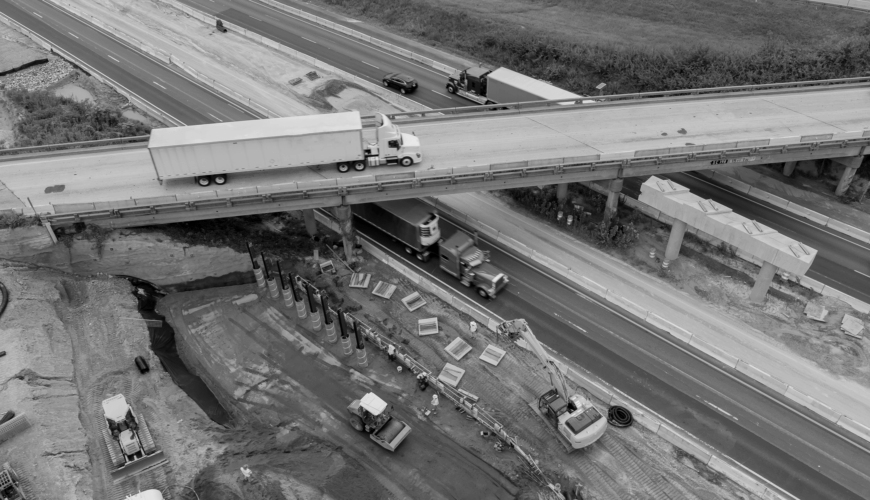Aging infrastructure the a quiet crisis that plagues the country’s must vital ports, highways and rail systems. The American logistics network is a marvel of modern engineering. Every day, billions of dollars’ worth of goods move across highways, bridges, railroads, and ports—connecting suppliers to manufacturers, retailers to consumers. Yet behind this impressive scale and efficiency lies a growing and largely overlooked threat: the crumbling state of the infrastructure that supports it all.
While headlines often focus on supply chain disruptions caused by global shocks, a slower and more persistent challenge is unfolding at home. America’s aging infrastructure—decades-old bridges, underfunded ports, outdated rail systems, and congested highways—is silently eroding the reliability and efficiency of logistics operations across the country.
Aging Infrastructure – The Scope of the Problem
According to the American Society of Civil Engineers (ASCE), the United States received a C- grade on its most recent infrastructure report card. Among the most troubling findings:
- Over 43,000 bridges are classified as “structurally deficient.”
- One in five miles of highways is in poor condition.
- Major ports are often constrained by outdated equipment and limited automation.
- Rail bottlenecks persist in key freight corridors, especially where passenger and freight rail share tracks.
These shortcomings aren’t just theoretical—they result in real-world consequences: shipment delays, increased fuel consumption, higher maintenance costs for fleets, and growing safety risks for workers and drivers.
Why It Matters to Logistics and Supply Chain Professionals
Infrastructure isn’t just a public sector concern; it directly impacts the day-to-day operations of supply chain leaders. Poor road conditions lead to delayed deliveries and rising insurance premiums. Limited port capacity increases lead times and contributes to bottlenecks. Inadequate intermodal connections reduce flexibility and make it harder to recover from disruptions.
For companies managing complex distribution networks, infrastructure quality plays a critical role in decisions like:
- Site selection for warehouses and fulfillment centers
- Route planning and transportation mode optimization
- Service level agreements and delivery promises
- Long-term capital investment strategies
As more businesses embrace just-in-time or omnichannel fulfillment models, the reliability of physical infrastructure becomes inseparable from supply chain performance.
Recent Policy Shifts and Investments
The Infrastructure Investment and Jobs Act (IIJA), passed in late 2021, marked a major step forward. The $1.2 trillion package earmarked significant funding for roads, bridges, transit systems, and ports, with more than $110 billion specifically allocated for transportation infrastructure.
While this funding is promising, the impact will take years to materialize—and execution remains uneven across states and local jurisdictions. In the meantime, logistics professionals must continue to operate in a landscape shaped by deferred maintenance and outdated design assumptions.
What Companies Can Do Now
1. Incorporate Infrastructure Risk into Site Selection
When choosing new distribution centers, companies should evaluate infrastructure resilience alongside labor availability and real estate costs. This includes proximity to well-maintained highways, access to multiple transportation modes, and the presence of disaster-resistant design features.
2. Build Contingency Routes into Transportation Planning
Redundant routing options and real-time data analysis can help mitigate the impact of road closures or bridge failures. Transportation management systems (TMS) with live traffic and weather integrations are becoming essential.
3. Advocate for Strategic Infrastructure Improvements
Businesses—particularly those with large freight volumes—should work with industry associations to advocate for targeted infrastructure upgrades. Partnering with local governments on public-private infrastructure initiatives can accelerate improvements in critical freight corridors.
4. Invest in Yard and Facility Automation
While external infrastructure remains a variable, companies can improve internal flow through automation in their own yards, docks, and facilities. Smart scheduling and yard management systems reduce dependence on external timing variables.
The Long-Term View
Infrastructure rarely fails overnight. Its decline is gradual, often masked by short-term fixes and operational workarounds. But over time, the cost of doing nothing accumulates—both in dollars and lost competitive advantage. As supply chains grow more integrated and time-sensitive, infrastructure becomes a strategic asset or liability.
Companies that proactively account for infrastructure risk and engage with broader policy conversations will be better positioned for the future. Those that don’t may find themselves paying the price—not in headlines, but in hidden costs, missed deadlines, and lost opportunities.
Conclusion
The quiet crisis of aging infrastructure won’t grab attention like a factory fire or a global pandemic, but its impact is just as real—and often more persistent. For logistics and supply chain professionals, it’s time to treat infrastructure not as a given, but as a strategic variable that demands attention, investment, and long-term planning.


